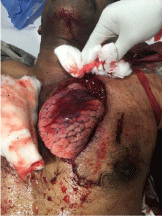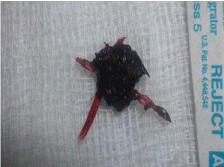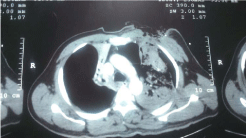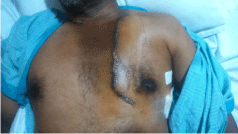Case Report
Surgical Management of Traumatic Lung Herniation Following Penetrating Chest Wall Injury by Atypical Vertical Thoracotomy: An Uncommon Case Presentation
Sanjeev Kumar K*, Sanjay A and Vijay D
Department of Cardiothoracic Surgery, Apollo Hospital, India
*Corresponding author: Sanjeev Kumar Khulbey, Department of Cardiothoracic Surgery, Apollo Hospital, Apollo Health City, Jubilee Hills, Hyderabad, India
Published: 23 Sep, 2016
Cite this article as: Sanjeev Kumar K, Sanjay A, Vijay D.
Surgical Management of Traumatic
Lung Herniation Following Penetrating
Chest Wall Injury by Atypical Vertical
Thoracotomy: An Uncommon Case
Presentation. Clin Surg. 2016; 1: 1138.
Abstract
Traumatic herniation of intrathoracic organs after penetrating injury is uncommonly seen in
medical literature. The management protocols in these cases are not well established. A 46 years
old man presented with left lung herniation following accidental penetrating chest injury. After
stabilisation he was managed uneventfully with lung laceration repair and removal of foreign body
through atypical vertical thoracotomy. The chest wall stabilisation was established with rib fixation
and anatomical muscle closure.
Keywords: Traumatic lung herniation; Chest wall; Vertical thoracotomy
Introduction
Traumatic herniation of lung following penetrating chest injury is a rare and uncommon presentation. We report the case of 46 year old male who had penetrating injury to left anterior chest wall resulting into massive herniation of left lung upper lobe, left haemo-pneumothorax, multiple rib (1 to 4) fracture and fracture dislocation of clavicle. After stabilisation surgical repair and removal of foreign body through atypical transcostal vertical thoracotomy and anatomical closure of muscle resulted in uneventful recovery.
Case Presentation
A 46 year old man admitted to Emergency department of our hospital alleged to have injury to
left anterior chest wall while he was working on electric saw used for cutting bricks. He was presented
in respiratory distress, profuse bleeding from chest wound with borderline systemic blood pressure.
He also had massive herniation of left lung from chest wall defect (Figure 1). The patient was awake
and anxious and forced to take deep breath. Due to which lung was protruded out and irreducible.
After evaluation patient was intubated with single lumen tube selectively ventilating the right lung.
The local examination revealed crushed fracture of left clavicle with multiple rib (1 to 4) fractures.
The major part of left upper lobe of lung was protruded outside.
The lung appeared pink and healthy. Part of lung was lacerated with
no active bleeding seen. Small spurts were seen from muscle and
subcutaneous plane which were secured. The lung was reduced back
carefully to avoid further injury by broken ends of fractured ribs.
One intercostals drainage tube was inserted on the same side for
drainage. Computerised tomography scan revealed chest wall defect,
fracture dislocation of clavicle, multiple rib fractures, left haemopneumothorax,
partial left lung collapse with foreign body in lung
parenchyma and bilateral lung contusions (Figure 3). Bronchoscopy
showed small blood clot with mucous plug with no evidence of
intraluminal injury. After stabilisation patient was taken up for
surgery in general anaesthesia. The Patients was placed in the supine
position with a small roll under the left shoulder. The patient’s arms
were tucked. As the open wound was present in left parasternal area,
lower end of wound was extended in the line of conventional anterior
thoracotomy for proper exposure of left lung (Atypical transcostal
thoracotomy). On exploration, besides lung no other intrathoracic
organ damage was observed. Subclavian vessels and brachial plexus
were exposed with no sign of injury. Medial part of left clavicle was
fractured, avulsed and totally crushed. Multiple ribs from first to
forth were fractured in the line of laceration. Irregular star shaped
sharp metal object was found embedded into lung parenchyma at
the site of lung laceration (Figure 2). The foreign body was taken
out and lung laceration was repaired with 4-0 prolene interrupted
sutures. The suture was reinforced with surgical glue. No major air
leak was observed. The pleural cavity was lavaged thoroughly with
Betadine-saline solution. All bleeding points were secured. The ribs
were approximated using steel wire. Spiculated end of clavicle was
trimmed. Chest wall defect was repaired with anatomical closure by
mobilising pectoralis major muscle. Aseptic closure of subcutaneous tissue and skin was done in usual manner.
The patient was gradually extubated on first postoperative day.
Rest of the hospital stay was uneventful and he was discharged on 7th
postoperative day (Figure 4).
Figure 1
Figure 2
Figure 3
Figure 3
CT scan shows open communicating wound in the chest wall with lung contusion and pneumothorax.
Figure 4
Discussion
Lung herniation is an uncommon presentation following chest
trauma [1,5]. Massive herniation of lung is rarely seen with penetrating
or blunt chest injury [2]. In cases of lung herniation anterior chest
wall is the site of predilection because of deficient muscular support
as normally present in the back by trapezius, latissimus dorsi and
rhomboid muscle [3]. Along with this as in our case anterior thorax
is frequently associated with multiple rib and clavicle fracture,
especially at sternum and costochondral junction, where intercostals
muscle layer is thinnest [4].
Computerised topography scan of chest is diagnostic for lung
herniation. It can show the chest wall defect with herniated part of
lung and also the condition of underlying lung. Management depends
upon the condition of herniated lung (viable/non viable), condition
of patient and site, size and type of chest wall defect [1,5]. Surgical
management is treatment of choice in cases of lung herniation with
open chest wall defect. For exploratory thoracotomy plan for the site
of incision is important. Extending the site of laceration over chest
wall into atypical transcostal vertical thoracotomy helps in avoiding
the pain and morbidity of second incision in postoperative period.
This incision allows complete inspection of other intrathoracic
structure like heart, pericardium, Subclavian vessels, brachial plexus,
phrenic nerve and diaphragm. The lung laceration has to be sutured
carefully to prevent air leak and allows early recovery. For better
stabilisation of chest wall, fractured ribs can be fixed with steel wire
followed by muscle closure.
Conclusion
Judicious surgical management in cases of traumatic lung hernia following penetrating injury of chest wall gives excellent postoperative results with less morbidity and mortality.
References
- Clark AJ, Hughes N, Chisti F. Traumatic extra thoracic lung herniation. BrJRadiol. 2009; 82: e82-84.
- Lang-Lazdunski L, Bonnet PM, Pons F, Brinquin L, Jancovici R. Traumatic extra thoracic lung herniation. Ann Thorac Surg. 2002; 74: 927-929.
- Maurer E, Blades B. Hernia of lung. J Thorac Surg. 1946; 15: 77-98.
- Khalil MW, Masala N, Waller DA, Cardillo G. Surgical repair of post traumatic lung hernia using a video-assisted open technique. Interact Cardiovasc Thorac Surg. 2008; 7: 506-507.
- Francois B, Desachy A, Cornu E, Ostyn E, Niquet L, Vignon P. Traumatic pulmonary hernia: Surgical versus conservative management. J Trauma. 1998; 44: 217-219.




